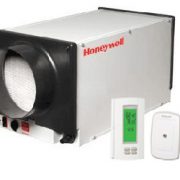When to Use a Dehumidifer
In my years in the trade I have always had that question by the customer. Why does my thermostat read 75 degrees but it does not feel like 75 degreesThe first thing is not to confuse temperature with humidity.
Humidity is something we hear about daily in weather reports. Humidity is the blame for that muggy, steam-room feeling experienced on certain summer days. Humidity can be measured in several ways, but relative humidity is the most common. In order to understand relative humidity, it is helpful to first understand absolute humidity.
Absolute humidity is the mass of water vapor divided by the mass of dry air in a volume of air at a given temperature. The hotter the air is, the more water it can contain.
Relative humidity is the ratio of the current absolute humidity to the highest possible absolute humidity ( which depends on the current air temperature ). A reading of 100 percent relative humidity means that the air is totally saturated with water vapor and cannot hold any more water vapor.
Individuals are very sensitive to humidity; the body relies on the evaporation of sweat to provide cooling for the body. The process of sweating is the body’s attempt to keep cool and maintain its current temperature. If the air is at 100-percent relative humidity, sweat will not evaporate into the air. As a result, a person may feel much hotter than the actual temperature when the relative humidity is high. If the relative humidity is low, we feel much cooler than the actual temperature because our sweat evaporates easily and cools us off.
People tend to feel most comfortable at a relative humidity of about 45%.
To avoid any mold problems, the indoor humidity should always be maintained below 55% (ideally between 30% and 50% ) relative humidity is recommended for comfort.
There are many different types and brands of dehumidifiers used to control moisture in crawlspace areas.
Why Do I Need a Whole-House Dehumidifier?
Have you ever experienced any of the following uncomfortable and/or unhealthy conditions:
1. Do you have trouble sleeping at night due to clammy skin or stuffiness in the air?
2. Have you ever reduced the temperature setting because you’re uncomfortable with the stuffy feeling?
3. Have your floors or other surfaces ever felt sticky or sweaty?
4. Are you concerned with mold and mildew growth in your home?
5. Do you have musty odors or smells in any area of your home?
6. Do you have condensation on your water pipes?
7. Have you seen wet stains on walls or ceilings?
8. Do you or a family member have allergies (over-moist air can encourage the growth of mold, bacteria, and dust mites, three commonly known household allergens).
9. Experiencing any of the above conditions can make sleeping and even daily activities miserable plus some conditions can be hazardous to your family’s health or your home’s furnishings.
10. Do you tend to get sick more offend that expected?
Did you know?
That dust mites (and their waste products) are one of the most common triggers for allergies and asthma? The Environmental Protection Agency advises keeping your home’s relative humidity between 30-50% to avoid dust mite infestation.
Please call us today to help you resolve your humidity and crawlspace issues.

